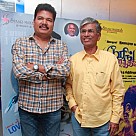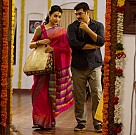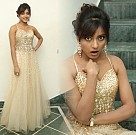“NONE OF OUR ACTRESSES ARE SIZE ZERO” - DHATSHA PILLAI
Interview Team : Anita; VenkatSpectrum of colours reflecting through the windows, heels of all kinds decorating the shelves, motifs designing the wardrobe, anything and everything a girl would wear - a woman’s paradise indeed. This was the scene at Dhatsha Pillai’s fashion studio; a boutique akin to the stuff of most women's dreams.
Dhatsha Pillai is a costume designer, who started her career with Dishyum and has worked for a range of films like Thalaimagan, Pirivom Santhippom, Mozhi, Vellithirai and Jannal Oram, to name a few. The purpose behind my visit to her studio was to take a serious interview, but it turned out to be an endless conversation between two women about clothes, the way fashion is perceived, the symbolic intention behind using certain fabrics and some interesting methods she used in her most recent venture, Meaghamann.
PHOTOS & STILLS - GALLERY
Lets start with your last release, Meaghamann. How was the experience?
This film has been a wonderful experience because for once, the director did not tell me what to do and what not to do!
Isn’t that what a director is supposed to tell you?
Well, no. Usually directors take references from Bombay magazines and ask me to design for our actors using that. But let's face it, none of our actresses are size zero! They give me clips of Katrina Kaif and other Bollywood actresses who are not even remotely close to our heroines. They will be seen in skimpy clothes like shorts and micro mini skirts which our actresses can’t wear.
But let's face it, none of our actresses are size zero!
Then, how do you draw a design for each character in the script ?
It is called ‘Character analysing in script’. We do this for every character in a film. It starts from tracking the character’s school days. Only if we know which school a character goes, we can understand which college he or she will attend.
But, what if a character studies in a government school and goes to a posh college?
That confusion won’t happen. Which is why we draw an in-depth character sketch. For instance, if you tell me which school you studied at, where you usually watch a movie and what your most common hangout place is, I can tell you where you usually shop and what kind of clothes you wear. That’s how we sketch the background of a character. We did this as an extensive exercise for Meaghamann.
So, how does the psychology of a character affect what they wear? Do colours play a role here?
Yes, it matters. If you understand psychosociology, it is predetermined and prescribed as to what kind of clothes a character from a specific background will wear. For instance a stunt guy will never wear colourful clothes. Shrink doctors usually use this kind of study as they read about their patients’ history fully to diagnose a problem. Similarly, patterns and colours used for a character completely depends on their background. You can’t show a girl studying in Quaid-E-Milleth college wearing shorts; that won’t convince our audience. But you can show a girl from Stella Maris in shorts. However stereotypical it sounds, that is the psychology of people.
But you can show a girl from Stella Maris in shorts.
Coming back, so how did you go about designing for Meaghamann? What were your criterias?
In Meaghamann, there were loads of characters. There were literally different groups of thugs. The director wanted only one thing. He wanted all his thugs to look classy and elegant! Now that’s the irony of the situation. It was a huge challenge. But in this case, he gave me the liberty of doing the character sketch of each character. Despite me not knowing Tamil, he made me read the script a million times. So, if you had noticed, even the last thug in the group will look neat and decent. That’s the level of detailing we gave for each character.
In Meaghamann, the director wanted all his thugs to look classy and elegant.
When you are focusing on such minute details, how do you go about documenting them? Since we are talking about costumes, what kind of notes do you fall back on?
We take our time and make something called a Costume Docket. Here we make sure how the character is and what kind of costumes a character usually wears. There is an inner limit and an outer limit of a person. This shows to what extent a character can wear glamorous clothes at her outer limit and traditional clothes to her inner limit. Everything will be between these two limits. For instance in Mozhi, Swarnamalya would have worn very distinct homely clothes. We would have used a lot of Bandhani and Vegetable dye print sarees. On the other hand she wears jeans too. So, as Sheela these are her two limits. When we write about each character, we make sure the extremes are pre-defined.
When we write about each character, we make sure the extremes are pre-defined.
Right!! Sometime back those loose pants were called parallel pants and now the same ones are called Palazzos. How do you look at the changing trend?
Fashion is a cycle, Anita. We make designs inside a circle. It is evolving, but it is going to be repetitive.
So, is there no innovation in this fashion cycle ?
We do innovate. It happens according to the changing times. We adjust according to the times and make designs. For instance during the early ages of films, women did not wear blouses but later blouses came. Then you saw different kinds of blouses with various designs. Now, again not wearing a blouse is the trend. So fashion is a constant, you use it according to the time.
Fashion is a constant, you use it according to the times.
Changing trends also change the mindset of people. We are becoming more open to viewing different kinds of clothing. How does the mindset of people from the film industry affect their characters’ clothing ?
Yes, mindset is definitely changing but we still have a lot of stereotyping. Excuse me for being blunt here, but why should a homely girl be seen only in a saree or a salwar? What about the women we see in our day to day lives? How about the girls who men date? Are they not homely? This is a very disappointing stereotype but most directors want to follow this. Sadly, that’s how even we are tuned to look.
Why should a homely girl be seen only in a saree or a salwar?
In a film’s crew, who are the people you should be in sync with?
It is very important to have a good rapport with the art director and camera person. We work out millions of options for each character and make appropriate costumes, but if the camera person is not convinced we may have to change the whole thing. In the North, Hindi movies are aesthetically loud and they use more colours than us. So we have to be very careful in choosing colours not just based on the role but also the camera. When it comes to designing for movies, it does not stop with viewing it through our naked eyes, it travels far beyond! It is an interesting profession only if you are patient, passionate and zealous.
Good luck Dhatsha!
In the North, Hindi movies are aesthetically loud and they use more colours than us.
FACEBOOK COMMENTS
OTHER LATEST INTERVIEWS
COSTUME DESIGNER DHATSHA PILLAI RELATED NEWS
- Yesterday turned to be a good day for Tamil cinema !
- Meaghamann on the lines of Kamal Haasan's cult classic
- Vijay's regular picks up Arya now
- Appreciation for Arya's Meaghamann
- The Christmas releases complete all formalities
- Meaghamann will release, come what may
- ''Even the proposed Pongal clash of 'I' Vs Yennai Arindhaal Vs Aambala is not good''
- A 'Quadra bonanza' for film lovers this Christmas?
- Meagaamann is READY !
- Vijay Sethupathi first, Arya second
- What next after Meaghamann?
- When is Arya's next releasing?
- Arya's Meaghamann is in its last leg
- A Dhanush – Ilayaraja treat before Anjaan
- Arya's next release on ...










